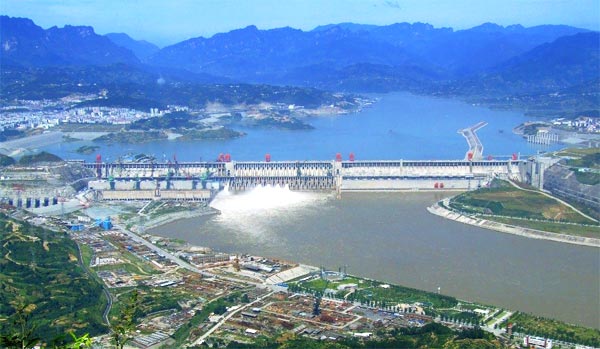see (G)
lago (P)
lake (e)
lac (F)
lago (I)
three gorges reservoir, yangtze river valley, china
Our Word of the day is lake (which means a body of water surrounded by land) and our Place is one of the largest manmade lakes in the world. Because that’s what a reservoir is: an artificial lake formed by putting a dam across a river and letting the water build up behind the river. Artificial lakes can be beautiful but always seem a little weird because they’ve been made by flooding places, displacing people and animals; and because they have some sort of dam or more likely, a hydroelectric dam, at one end. Remember the three convicts, Pete, Delmar and leader Ulysses Everett McGill, from the film O Brother, Where Art Thou?, who escape from a chain gang to try and retrieve a buried treasure before the area is flooded for a new hydroelectric dam.
There are so many interesting lakes in the world. Lake Bacalar, in Quintana Roo, Mexico, near Belize, known as the Lagoon of Seven Colors, because the color of its waters change according to the depth of its limestone floor. The Caspian Sea, which used to be a sea connected to the Black and Mediterranean Sea, and is now landlocked but still salty, bordered by five countries, and popular with many birds, including flamingoes. How about Lake Baikal in southern Siberia, Russia, which is not only the largest freshwater lake by volume (as much as all of the Great Lakes combined), holding 20 percent of the world’s fresh water; but is also the world’s deepest lake at more than 5300 feet deep. Or Lake Victoria, located in the countries of Uganda, Kenya and Tanzania, whose size is that of Ireland and whose waters are the source of the Nile River, which flows north from Lake Victoria through Egypt to the Mediterranean.
The Three Gorges Reservoir, our Place of the day, is located in the Yangtze River valley in China. Created by the Three Gorges Dam, the reservoir has a surface area of about 400 square miles and extends upstream from the dam some 375 miles. The reservoir was created by submerging large areas of the Qutang, Wu and Xiling gorges, hence the name the Three Gorges Reservoir. The reservoir is deep enough to allow for ocean going ships to sail 1400 miles inland from Shanghai to the city of Chongqing. Ships locks allow vessels to navigate past the dam and a ship lift even allows smaller vessels to bypass the ship locks and travel past the dam more quickly.

There had been talk throughout the 20th century by the Chinese government about building the world’s largest dam to manage the Yangtze River. It may only be in China that such a project could be done. The construction finally started in the 1990s, and it took over 15 years to complete. The dam is 7,660 feet long with a maximum height of 607 feet. and is the world’s largest hydroelectric dam. Construction of the dam caused the displacement of at least 1.3 million people (some say 1.9 million people) living in more than 1500 cities and towns and the destruction of natural features and some 1200 architectural and archaeological sites. The reservoir is also blamed for an increase in the number of landslides and earthquakes in the region. In 2020, heavy rains caused huge water flows into the reservoir, prompting fears that the dam could collapse or be breached.